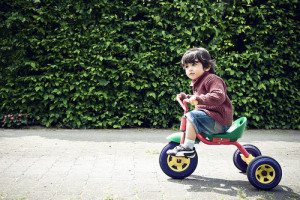
When Luke wrecked his bike, his parents—like any normal parents—examined him to make sure he was okay. He didn’t have any outward signs that he had been seriously injured. He stopped crying after a while, so they put him to rest in bed.
But the next morning, Luke was still in pain, with a fever, chills, and a racing heartbeat. His parents took him to the Monroe Carell Jr. Children’s Hospital at Vanderbilt, where he was admitted.
Like Luke’s parents, the doctors at first couldn’t find anything wrong with him. However, after doing exploratory surgery, they found that he had punctured his small intestine from landing on the handlebars of his bike.
The Tennessean reports that Luke was in the hospital for a week, and it took him a month to recover. This extremely serious injury could have cost Luke his life.
Soon after his recovery, Luke’s parents decided that they would try to prevent the same thing from happening to other kids. Dave Meyer explained, “We were both convinced that we could stop this from happening to other kids.”
This frightening experience galvanized the two into action, and their efforts resulted in the creation of the “handlebar helmet.” The handlebar helmet is a plastic device, shaped much like a mushroom, that is fitted onto the ends of a bicycle’s handlebars. The device works to spread out the impact of the handlebar during a fall, according to Dave Meyer.
Most parents are—rightly—concerned with making sure that their kids wear a helmet when riding a bike. However, fewer know about the danger of abdominal trauma.
According to The Tennessean, the National Center for Biotechnology Information reports that abdominal injuries caused by bike riding are not uncommon and are not always immediately apparent. A study reported by the National Center for Biotechnology Information found that “children who suffer from direct impact of the handlebars are more likely to require operative intervention and have a longer LOS [“length of stay” in the hospital] than those who flip over the handlebars.
Head injuries are more common, but abdominal injuries do happen, according to Dr. Tobi Amosun, assistant professor of Clinical Pediatrics at the same hospital that treated Luke.
Summer is the season that sees the most bicycle injuries among children and adults—when everyone is outside enjoying the nice weather.
Whenever your child rides a bike, make sure that he or she is wearing a properly fitted helmet. This applies whether he or she is riding in the street or in the backyard. Also, he or she should wear reflective clothing and be familiar with the terrain. The bike should be the right size, and the tires should be fully inflated.
Taking precautions can help reduce your child’s risk of an accident. However, if one does happen as a result of someone else’s negligence, please call the bicycle accident lawyers at Martinson & Beason, P.C. to learn your options.
Photo Credit: <a href=”https://www.flickr.com/photos/34547181@N00/7191186030/”>Philippe Put</a> via <a href=”http://compfight.com”>Compfight</a> <a href=”https://creativecommons.org/licenses/by/2.0/”>cc</a>